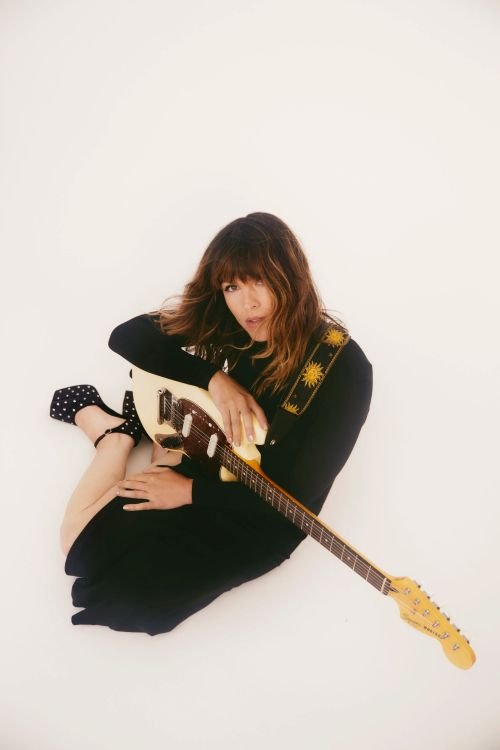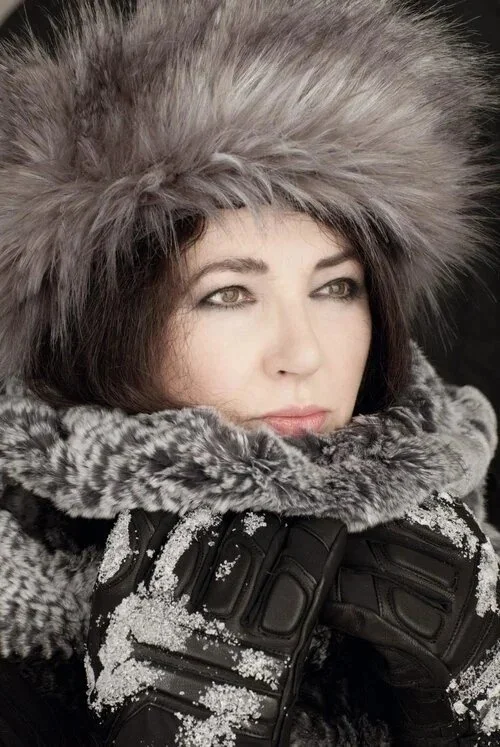FEATURE:
Modern-Day Queens
of Melody Prochet, Melody’s Echo Chamber is one of the queens of modern music. I am featuring her in this feature as I really love her music and new album, Unclouded. I will end with a review of that album. If you are not aware of Melody’s Echo Chamber, it is the work of the French-born musician. In terms of style, you might describe the music as s Dream Pop, Space Rock and Psychedelic Rock. I think that Unclouded is one of the best albums of this year. A typically beautiful and memorable album from a sensational songwriter. I am going to start by bringing in some interviews from last year. Make sure you catch Melody’s Echo Chamber on tour. I do wonder if there are any U.K. dates coming up, as people here would love to see her. She was in the country recently as she was being interviewed by, among others, BBC Radio 6 Music. I hope that more stations in the U.K. get behind her music as she is a wonderful artist that everyone should check out. There are three interviews I want to get to, before I wrap up with a review for Unclouded. I am going to start out with an interview from Occult Magazine:
“Back in 2012, Melody’s kaleidoscopic psych-rock/pop debut album, Melody’s Echo Chamber, was essential on arrival— it was a defining psych album of the 2010’s that inspired the many waves of artists to follow. Melody’s sophomore record Bon Voyage was even more ambitious, taking her sounds in bold new directions– it reinforced the notion that Melody would continue to be a multifaceted force.
Tomorrow December 5th, Melody will release her 4th official studio album– Unclouded, which is a brilliant meshing of two worlds. The vivid, psychedelic visions of Melody’s Echo Chamber remain prominent, but they are emphasized by the rich and exotic orchestral escapism of Swedish composer/producer Sven Wunder, who co-wrote and produced Unclouded. The production and instrumentation lifts Melody’s grounded perspective, and paints her shimmering tunes into the audio equivalent of a gorgeous impressionist painting. Melody floats over the elegant sonic palette effortlessly, and the record truly feels like a breath of fresh of air.
BEAU: I'm very excited for the release of Unclouded– It's a very beautiful, vibrant, and very rich album. It's been a few years since your last release. How does it feel to bring this new version of yourself to the world at the moment?
MELODY: Thank you. Yeah– it's been a while. Recording this new music kind of sparked a new light in me– this new sense of faith somehow. So it's very exciting and really special.
BEAU: Yes– It has a very grounded, positive, peaceful tone that really resonated with me.
MELODY: Oh, thanks. That means a lot!
PHOTO CREDIT: Diane Sagnier
BEAU: So I've had your music and rotation for plenty of years since your debut Melody’s Echo Chamber, but Sven Wunder’s music is a more recent obsession–I actually discovered his records during the pandemic. I loved Eastern Flowers and Wabi Sabi– and his record this year, Daybreak, is really great.
Unclouded is a really great link up of both of your worlds. Sven’s touches compliment your work, and vice versa in the process. I'd love to hear how the collaboration came about.
MELODY: I discovered his music a few years ago with the song “En Plein Air”. I had an instant crush, and I was like, “Oh, I really want to float and sing into this landscape”... and those lush and luxurious sounds. It felt really organic and absolutely mind blowing. I really wanted to try to work with him, so I reached out to him, and at the same time, I reached out to El Michel's Affair. I was looking for producers and both really wanted to do it.
Timing wise– it worked out with Sven Wunder, more fluidly and easily. So that was really special. I just crashed my soul into his world and same with him. So that's really exciting and terrifying at the same time, because we didn't know each other at all. The first song we worked on was “Memories Underground”, which was a really small demo of mine, it was shoegaz-y… guitar-y.. We really clicked and matched on this one. From this song, we knew it was going to work out okay– and it did.
BEAU: So, you also have an incredible roster of musicians on this record too.
MELODY: Yeah, it's true. I'm really lucky.
BEAU: I really love the break beats– that snappy drum sound is a big personality on the album. How did you decide on the members of the band for this record? I did see that some of the tracking was done separately.
MELODY: Yeah, the process was really new to me, and Sven Wunder's ideas were really incredible. We first went into his studio and with my demos, a little bit of his demos as well, we both had material to share, and to see what would inspire us.
We started in his studio with him, he was ripping drums that we love from his program. He could get like my favorite Can-beats and drumming modern or old, so we could just work on amazing material.
And then we had to recreate that, which was another challenge– but we knew we could manage with some really great drummers. His partner at Piano Piano Records came up with the idea of Malcolm Catto, which is legendary– but I never thought I could work with him.
PHOTO CREDIT: Diane Sagnier
He managed to contact him and got him to come on board. So we went to Dalston in London, an incredible neighborhood. We recorded Malcolm in his incredible studio, which was set in a community center. It was really raw and authentic, and he was like coming down into a cavern of analogue…it was insane. He's absolutely the best at doing that whole kraut-rock, meets rock, meets soul/hip-hop…this whole jazz fusion thing– he makes it all into his own story.
It was perfect for us to have this consistent and classic sound towards the whole record. That's what I wanted– and that's what I also thought Sven Wunder had in his own records, which he usually records with all Dina Ögon’s musicians. So that's why we also went to record Daniel Ögon and Love Orsan from Dina Ögon– the amazing Swedish band, so that was all pretty natural.
BEAU: You know– I feel like Unclouded kind of resolves with those last two tracks before “Daisy”... (“How to Leave Misery Behind" and the title track.) Then “Daisy” is like a new beginning at the end.
MELODY: Exactly! That's why I put it in the end. I felt like it was the start of the next chapter somehow…
BEAU: So what can you tell me about “Daisy” with El Michaels Affair – it's a beautiful song.
MELODY: I was listening to his music– we were going to play together in Mexico around 2023. I had never heard of his music before, which is crazy, but I discovered his music there and I was like “Oh, that would be the perfect match!”.
So I reached out to him, and he loved my work and we spoke on the phone. We were like “let's try to make something!”. So he sent me some beats and pieces and I worked on it. I completely made a whole new thing out of it. It was just like a little playground between our two worlds– that was really cool.
I'm working on a new track that he sent to me, and I think we will do some more for sure.
Also I had his mixer– Jens– who mixed the record, which was a game changer really, because he has such a special sound. So that really changed my life as well”.
Before getting to an interview with CLASH, I want to drop in this one from Flood Magazine. An artist that creates this alchemy, Melody’s Echo Chamber drew inspiration and strength from art therapy. Working with producer Sven Wunder, Prochet created this incredible and immersive album. One that is “a warm, colorful tapestry of dreamy psychedelic rock, a kind of phantasmagorical canvas that lets the listener interact with its world in a meditative way”:
“When discussing her creative process, Prochet gets esoteric and spiritual. To her, creativity is about alchemizing the bad into something good—in her words, “turning shit into gold.” Like a powerful sorceress, she sees it as a divine process. She even considers creativity a goddess, much like Sophia of the Gnostics or Athena of the Greeks, as she references Dreams Unlimited’s Arise installation for Burning Man, a sculpture representing the mother of transformation and creation. Creativity and self-expression are crucial because they help her process hard moments and emotions, even if they’re difficult to articulate. “My song ‘Into Shadows’ was pretty bad—I tried to put words to it, and they would never come,” she explains. “So I used ‘La-la-la,’ and I thought, ‘It’s OK to not be able to name things that are really hard.’ It’s another way to express it.”
To help herself get into a creative mindset, Prochet goes for walks, creates vision boards, and finds new ways to make music. She gets particularly excited when talking about using reference drums from artists as diverse as My Bloody Valentine and Little Simz, re-contextualizing them into something completely different as a jumping-off point. To her, creativity is everything—a reason for being. “It makes me love living, and I have so much tenderness now for the living experience,” she shares. “There’s the same sort of magic in creating anything—it’s not just music or art, it’s definitely finding a solution to anything, to any problem.”
Although she loves art, Prochet acknowledges that it’s a privilege to make a living off of it. The world is bigger and more complicated when you factor in the real people and real consequences that lie beyond the creative world. She points out that what’s going on in American politics is terrifying, but she has hope for what’s to come. “That’s what I mean by ‘unclouding’: taking that responsibility to exist and uncloud your own mind so you can resist. Your mind can resist all those things in your own way, every day. But that’s definitely something on my mind,” she explains, referring to the harm done by the Trump Administration.
Prochet also hints at what’s next. Although they only worked on the new album’s track “Daisy” together, she and producer Leon Michels have been thinking of co-producing a full-length album in the near future. Michels—a founding member of El Michels Affair and Lee Fields’ backing band The Expressions, and known for working with artists like Clairo, Kali Uchis, and The Black Keys—has a classic-soul touch to his psychedelic production work, which she gravitates to. “Leon sent me a very classical French-sounding song that I didn’t finish, but it was quite sweet. But I think I would not want to go there. I think I would probably want us to create something new together”.
Although it has been a while since she last released an album, you feel the time away was crucial. In terms of her songwriting. More vital and extraordinary than ever before. Even though there have not been huge music changes, you can feel this progress ands shift on Unclouded. Last month, CLASH spoke with Melody’s Echo Chamber about one of the more underrated albums of 2025. I think that she is one of the most special artists that we have:
“What brought you back into the studio? Was there a specific moment in your life that prompted you to start writing and recording again?
That’s a good question. There were multiple reasons, but the main one was going back on tour in 2023 across the United States. I got such a drive from the audience because they were the sweetest, and it all started to make sense again. Meeting all those people and getting so much energy in return was magical … it reminded me why I make music.
Also, I heard a lot of amazing new music that gave me butterflies and made me want to start making music again. Artists like Crumb, Saya Gray, Water From Your Eyes, SAULT, Tyler the Creator, El Michels Affair and Sven Wunder, my co-producer — all this amazing, visionary, avant-garde production is what inspired me. It’s as simple as that, really.
You’ve named several artists who inspire you, but do you wish to work with them or does Melody’s Echo Chamber function best with just you calling the shots?
It depends on the phase I’m in, but I love to crash my world into someone else’s. I made a little song with Crumb a few years back, which was really cool. I find working with others deeply enriching, though it can be challenging since I have a strong vision of what I want to create.
This record was very collaborative, but I wanted my vision to be even stronger than before. I chose to give other people quite a lot of space on my last two records, so I wanted to guide the project more this time.
Your arrangements and texturing play a key role in giving the album an immersive feel, especially on tracks like ‘Eyes Closed’. How much of that comes from you versus the musicians you bring in?
I see myself more as a sculptor. We had some pretty well-written demos before bringing in the other musicians, who we chose for their sound and soulfulness. Actually, we went to their spaces to record. We were at [drummer] Malcolm Catto’s cavern and using analog gear, so it was quite special. I’m great at capturing people’s hidden treasures, which I then combine with my own ideas.
My passion is editing, so there are all these magical little moments that I’ll loop and arrange into a kind of hip-hop collage. That’s my little vision, but then Sven worked really hard on the string arrangements. I guided the distortion, the bends and all those small ideas, but he shaped the landscape. It’s hard to give a clear answer about who did what because the planets just sort of aligned, and everyone contributed in their own way.
The title track of the new album has no lyrics, yet it is deeply poignant. What can you tell us about the word ‘Unclouded’ — why that name, and is there a core theme that ties all 12 songs together?
I settled on the title very close to the deadline, just one day before we had to master the songs. I wanted one word that summed up the record, so it wasn’t easy. I actually got it from a [Hayao] Miyazaki quote, but it’s really about how I’m constantly trying to uncloud my mind every day — finding clarity, clearing up clouds of disinformation and being free of judgment; protecting my sense of discernment and nonbinary thinking. It’s difficult to stay unclouded in modern times, and it takes a lot of hard work.
It takes little acts of resistance to be a decent human amid all this chaos. I feel a lot of anger at what’s happening in the world, so my philosophy is to take full responsibility for my inner sky. To me, the song ‘Unclouded’ feels like being in an aligned and peaceful state.
Why did you position the song second-to-last on the tracklist?
That was actually supposed to be the end of the record, but then my track with Leon Michels (of El Michels Affair) ended up being the last. I loved the idea of putting ‘Daisy’ at the end, because it’s like a doorway to other adventures and maybe another chapter. I think Leon and I are going to work together more, so it made sense to have our song close the album while opening a new story.
What about the album cover — is that something you put a lot of thought into or was it more of an impulse?
This kind of goes back to the previous question, because it’s always been challenging for me to incarnate my music in terms of physical identity. I’m very much an introverted shoegazer and I’ve never wanted to sexualise my looks, so I’ve always preferred artwork where I’m not fully present, but still there. I worked with a really cool graphic designer, and we just kind of put together all these ideas I had — me standing with an instrument, nature ornaments, green tones”.
I am going to end with a review of Unclouded from SPIN. If some felt that there was some repetition on the double album and a more judicious editing process could have taken place, I think that CLASH say it best: “Overall, ‘Unclouded’ is a further incantation of psych-pop goodness”. SPIN had some positive words for a dreamy and memorable album from this astonishing artist:
“For more than a decade, Melody Prochet’s songs have drifted through dream logic — language dissolving into texture, emotion refracted through haze. Unclouded, her fourth album as Melody’s Echo Chamber and third for Domino Records, doesn’t abandon that ethereal quality thanks to the arrival of the Swedish producer/songwriter Sven Wunder, best known for the lush psych-jazz soundscapes of his own dazzling discography. But here, Wunder grounds her pastel palette with something newly tactile: breakbeats, supple bass lines and strings that move like muscle rather than mist.
From the start, the rhythm section does as much storytelling as the lyrics. On opener “The House That Doesn’t Exist,” Love Örsan’s bass and Heliocentrics legend Malcolm Catto’s drumming lock into a groove that summons the home Prochet’s singing about — one built from motion and heartbeat rather than stone. “In the Stars” introduces Wunder’s calling cards with gliding strings, boom-bap beats and a melody that pirouettes between melancholy and delight. Lyrics about “finding a place I can call mine” land harder because the music itself sounds like a destination.
That physicality animates the whole record. “Eyes Closed” and “Childhood Dream” surge forward with frenetic drumming and burbling bass, tracing the boundary between control and surrender like a chocolate mushroom trip along the French Riviera. Even when the drums on “Burning Man” become purposefully muffled so as to sound like they’re in a closet two rooms over, keyboard glissandos and a Per “Texas” Johansson flute solo keep the music moving on a heavenward trajectory.
There’s still mystery here, but it’s less about distance than transformation. Unclouded reveals how clarity can coexist with psychedelia and how groove can sharpen the emotional frame rather than smudge it. Wunder’s graceful, deeply felt arrangements are key to that proposition, as Prochet’s lyrics about impermanence and renewal, once opaque, now feel illuminated by the rhythm itself.
By the time the album winds down with the Stereolab-flavored “Broken Roses” and the resolute “How To Leave Misery Behind” (“please be kind,” she pleads), Prochet has seemingly mastered the art of staying present inside the flux and dancing within the blur instead of floating above it. Throughout Unclouded, the music breathes, the feelings land and the vagaries of life are evermore illuminated”.
Go and follow Melody’s Echo Chamber. Even though she has been on the scene for a while now, the music is still fantastic and changing. Unclouded is the latest chapter from the French songwriter. Someone I hope visits the U.K. this year and plays. If you have not heard her music then go and check it out now. She is someone that everyone should seek out. Truly, a majestic songwriter whose music…
IS among the best out there.
___________
Follow Melody’s Echo Chamber
PHOTO CREDIT: Diane Sagnier
Official:
https://melodysechochamber.com/
Instagram:
https://www.instagram.com/melodysechochamber/
Twitter:
Facebook:
https://www.facebook.com/MelodyProchet/
Spotify:
https://open.spotify.com/artist/1S0vL284jxZYKtZQ2jsQ2X?si=GGYB5dPwTbOlUL8N6Nssxw
YouTube:































































